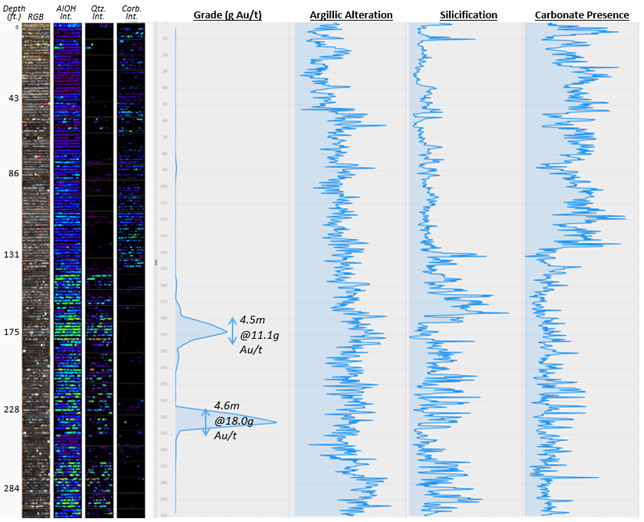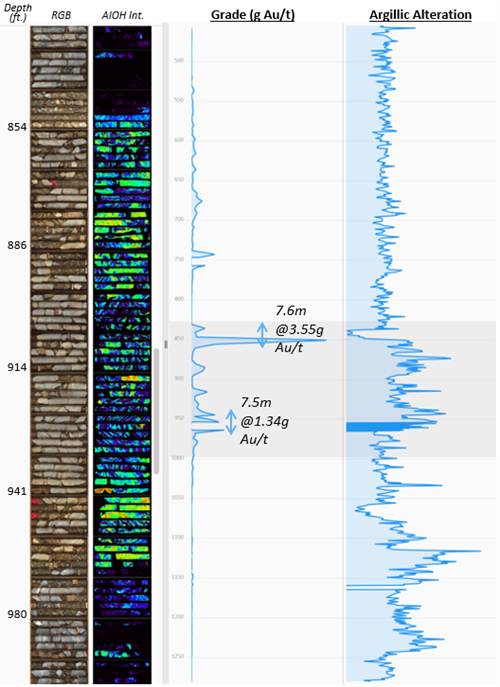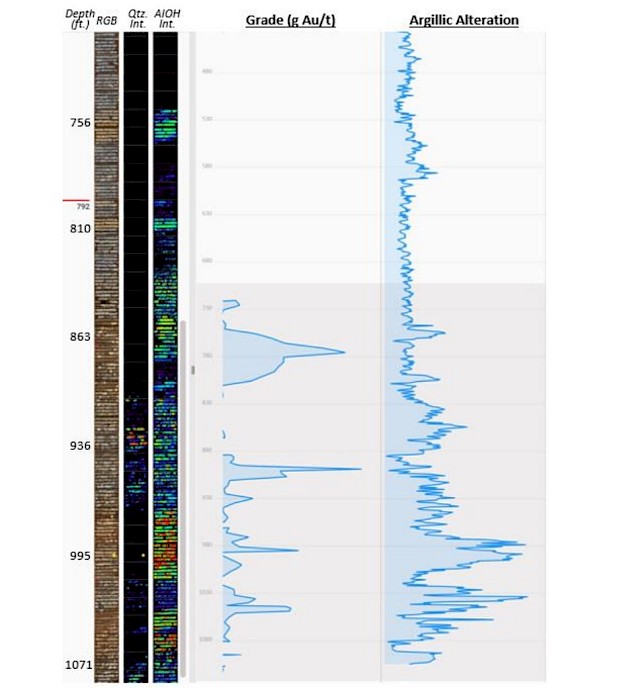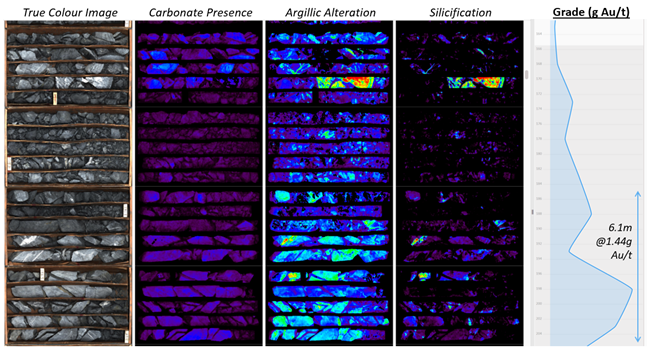Vancouver, British Columbia, November 9, 2021 – Westward Gold Inc. (CSE: WG, FSE: IM50) (“Westward” or the “Company”) is pleased to announce the results of its previously-disclosed hyperspectral core imaging and airborne hyperspectral campaigns at its Toiyabe and Turquoise Canyon Projects located on the Battle Mountain – Eureka Trend in Lander County, Nevada (“Toiyabe” and “Turquoise Canyon”, respectively) (see press releases dated August 10, 2021 and October 5, 2021 for reference).
The initial results of the two surveys confirm a large hydrothermal footprint at Toiyabe, resulting in alteration of favourable host rocks, predominantly the Wenban and Roberts Mountains Formations. These formations are also important hosts at many nearby large-scale gold mines and deposits, including Pipeline, South Pipeline, Crossroads, Cortez Pits, and Cortez Hills. The recent hyperspectral data builds upon the legacy data and improves understanding of the relationship between gold mineralization controls, and alteration. The newly-identified and quantified alteration will aid as a pathfinder to mineralization, allowing Westward to optimize future drill targets and potentially expand upon previous significant intercepts. The Company is in the process of planning its inaugural drill campaign for the first half of 2022.
Hyperspectral Core Imaging
TerraCore Geospectral Imaging in Reno, Nevada (“TerraCore”) performed hyperspectral core imaging on approximately 3,050 meters of diamond drill core and 9,140 meters of reverse circulation chips inherited from past operators. Hyperspectral imaging is captured through measuring the reflectance and absorption of infrared energy on the surface of the core. This non-destructive measurement quickly provides information about mineralogy, mineral chemistry, and mineral texture. TerraCore’s full-range hyperspectral system was utilized, producing high-resolution true colour photographs at 0.1mm resolution, and infrared images across the Near-, Short-, and Longwave-Infrared regions at 1mm pixel resolution. The wavelengths used are necessary for Carlin-type gold deposits given their ability to detect a wide range of minerals including clay, carbonate, silica, and associated alterations. All hyperspectral imagery is converted into an objective, numerical dataset that can readily be imported into the Toiyabe database and 3D model.
Key Highlights (1)
- Hydrothermal alteration associated with various styles of gold mineralization was assigned to four distinct categories: (A) Fault-controlled mineralization, (B) Carbonate lithology proximal to structure, (C) Carbonate lithology distal to structure, and (D) Quartz veining with argillic alteration
- Alteration Type A – Fault-Controlled Mineralization (see Figure 1 below) demonstrates a decreased carbonate presence, suggesting strong decalcification and silicification. Argillic alteration increases with proximity to the high-grade Courtney Zone in the southeast, as demonstrated in hole T-706 which had reported gold intervals of 5.5 g Au/t over 10.7 meters from 51.8 – 62.5m, including 11.1 g Au/t over 4.5 meters from 54.9 – 59.4m and a separate interval of 18.0 g Au/t over 4.6 meters from 71.6 – 76.2m, including 26.4 g Au/t over 3.1 meters from 71.6 – 74.7m
- Alteration Type B – Carbonate Lithology Proximal to Structure (see Figure 2 below) demonstrates silicification with argillic alteration halos extending up to 60m away from high-grade intercepts (+2 g Au/t gold). Hole T-1601 reported 3.55 g Au/t over 7.6 meters from 253.9 – 261.5m, including 13.2 g Au/t over 1.5 meters from 258.5 – 260m, and intervals of 1.22 g Au/t over 2.5 meters from 269.1 - 271.6m, 1.34 g Au/t over 7.5 meters from 286.8 – 294.3m. All intercepts are within the alteration halo observed in the core imaging dataset
- Alteration Type C – Carbonate Lithology Distal to Structure (see Figure 3 below) is similar to Type B but with lower-grade gold anomalies, likely caused by its distance to the mineralizing structure, yet still exhibits large alteration halos as seen with Type B
- Alteration Type D – Quartz Veining with Argillic Alteration (see Figure 4 below), though less common, exhibits decalcification and argillic alteration centered on silicified veins containing anomalous gold values. An example from hole 901C included 1.44 g Au/t over 6.1 meters from 56.4 to 62.5m
- Argillic alteration varies from zones of illite associated with structures and intrusive dikes/sills, to kaolinite associated with unique lower-plate carbonate rocks. Kaolinite appears to develop in specific units of the Wenban Formation, an important lower-plate gold host in the Battle Mountain – Eureka Trend
- In all mineralization types, the alteration appears to be centered around structures which act as fluid conduits and are generally associated with anomalous gold values. The broad zones of alteration observed in Types B and C, and the changes in mineralogy observed in Types A and D, provide key vectors to mineralization, and will guide future drill programs. The alteration present at the Toiyabe project is comparable to that observed in the nearby Pipeline and Cortez Hills deposits (source: NI 43-101 Technical Report on the Cortez Joint Venture Operations, Lander and Eureka Counties, State of Nevada U.S.A, Barrick Gold Corporation, Prepared by Hugo Miranda, Kathleen Ann Altman, Phillip Geusebroek, Wayne W. Valliant, and R. Dennis Bergen, March 22, 2019)
Dave Browning, Vice President of Exploration, noted “the large alteration halos will be crucial for exploration planning as they indicate areas of mineralization that may have been missed by previous drill campaigns. Understanding the association between anomalous gold values and alteration types will optimize our future targets and will inform our technical team during the drill campaign with regards to proximity of mineralization.”
(1) All gold intercepts referenced are historical results from previous operators; sources: NI 43-101 Technical Report, American Consolidated Minerals Corporation, prepared by Paul D. Noland, P.Geo., May 27, 2009; NI 43-101 Technical Report, Starcore International Mines Ltd., prepared by Paul D. Noland, P.Geo., May 11, 2018; NI 43-101 Technical Report, IM Exploration Inc., Prepared by Donald E. Cameron, August 5, 2021
Hyperspectral Airborne Survey
In conjunction with the core imaging, the Company also completed an airborne hyperspectral survey, carried out by SpecTIR, LLC and processed by Ethos Geological Inc. A total area of ~35 square kilometers has been processed, including both Toiyabe and Turquoise Canyon, and surrounding land. Near-, Short-, and Longwave-Infrared cameras were also used for the airborne survey to allow for direct comparison to the core imaging dataset. The airborne survey has identified alteration minerals along the surface expression of structures, indicating these structures likely acted as fluid conduits similar in nature to those observed in the Toiyabe drill core.
Key Highlights
- Argillic alteration as described in the core imaging at Toiyabe is observed at Turquoise Canyon in the form of muscovite and illite signatures
- The distribution of alteration minerals seen on the surface at Turquoise Canyon confirms previously-inferred structures, and is spatially associated with anomalous gold, silver, arsenic, lead, and zinc in soil
- Ammonium illite, an indicator mineral for fluid flow not detectable by the human eye, has been identified along near-surface structures in the core and at surface. Spatial extent of the ammonium minerals has identified hydrothermal fluid pathways leading to additional drill targets at the Toiyabe and Turquoise Canyon Projects
Mr. Browning also commented: “Having access to the drill samples from Toiyabe’s Courtney Zone (which hosts a historical 170 koz gold resource estimate (2)) is vital to understanding the alteration associated with mineralization in the district. Being able to identify that same alteration pattern via airborne hyperspectral data will lead to the identification of high-priority areas for follow-up sampling, mapping, and drilling at Turquoise Canyon. This correlation will reduce exploration risk and optimize future exploration spending across the district.”
(2) Source: NI 43-101 Technical Report, American Consolidated Minerals Corporation, Prepared by Paul D. Noland, P. Geo., May 27, 2009 (the “2009 Technical Report”). A qualified person has not done sufficient work to classify the historical estimate at Toiyabe (the “Historical Estimate”) as current mineral resources and Westward is not treating the Historical Estimate on Toiyabe as a current mineral resource, as defined in National Instrument 43-101 – Standards of Disclosure for Mineral Projects (“NI 43-101”). The Historical Estimate was calculated using mining industry standard practices for estimating Mineral Resource and Mineral Reserves (2005) which was prior to the implementation of the current CIM standards for mineral resource estimation (as defined by the CIM Definition Standard on Mineral Resources and Ore Reserves dated May 10, 2014). The key assumptions, parameters and methods used to prepare the Historical Estimate on Toiyabe are described in the 2009 Technical Report. While Westward considers the Historical Estimate on Toiyabe disclosed in this news release to be relevant to investors, it cautions readers that it should not be unduly relied upon in drawing inferences on the mineralization on Toiyabe, as additional work is required to upgrade or verify the Historical Estimate as a current mineral resource. This additional work includes (but may not be limited to): re-sampling and re-assaying of available core and/or pulps, verification of assay certificates and digital assay data, verification of select drill hole collars, review and verification of drill hole geologic logs versus the preserved core and RC cuttings, incorporation of AuCN assays to provide a general understanding of oxide presence, review and verification of mineralization controls and modelling techniques.
Conclusions and Next Steps
The initial results of the surveys confirm a large hydrothermal footprint resulting in alteration of favourable host rocks, predominantly Wenban and Roberts Mountains Formations. The hyperspectral data are currently being imported into the Toiyabe 3D model to determine true lateral extent and provide spatial context to the distribution of the mineralizing fluid. The data will continue to inform Westward’s technical team during drill targeting in anticipation of the upcoming 2022 program.
When completed, the model will provide the first 3D visualization of surface and subsurface data at the projects, with the goals of identifying and characterizing: (i) gold mineralization controls, (ii) on-strike and depth extensions to gold mineralization at the Courtney Zone, and (iii) new drill targets.
An induced polarization survey has also recently been completed across the Toiyabe and Turquoise Canyon Projects. Results are pending and will be imported into the 3D model for comparison to the airborne and core imaging hyperspectral campaigns.
Figure 1: Alteration Type A – Fault-Controlled Mineralization

Alteration Type A as observed in hole T-706. Images in order from left to right: True-color photo, Argillic Alteration, Silicification Intensity, Carbonate Presence. The graphs to the right display g Au/t and alteration displayed in the images to the left. A moderate carbonate response is present at the top of the hole with minimal silicification. Carbonate decreases in proximity to anomalous gold, with clay response and silicification being strongest in the high-grade zones.
Figure 2: Alteration Type B – Carbonate Lithology Proximal to Structure

Alteration Type B as observed in hole T-1601. Images in order from left to right: True-color photo, Argillic Alteration. The graphs to the right display g Au/t and alteration displayed in the images to the left. Argillic alteration is centered on the anomalous gold zone and extends for approximately 20 meters above and below the high-grade intercepts.
Figure 3: Alteration Type C – Carbonate Lithology Distal to Structure

Alteration Type C as observed in hole T-1001. Images in order from left to right: True-color photo, Silicification, Argillic Alteration. The graphs to the right display g Au/t and argillic alteration. Silicification is present with the strongest Au values, but none exceeded 0.8 g Au/t. Argillic alteration is present for approximately 30 meters above and below the silicification.
Figure 4: Alteration Type D – Quartz Veining with Argillic Alteration

Alteration Type D as observed in hole T-901 from a depth of 164 to 204 feet. Images in order from left to right: True-color photo, Carbonate Presence, Argillic Alteration, Silicification. The graph to the right display g Au/t. Mineralization is coincident with silicification surrounded by strong argillic alteration. Carbonate presence is weak indicating decalcification in the anomalous gold zone.
Qualified Person
The technical information contained in this news release was reviewed and approved by Steven R. Koehler, Technical Advisor to the Company, who is a Qualified Person under National Instrument 43-101 – Standards of Disclosure for Mineral Projects.
About Westward Gold
Westward Gold is a mineral exploration company focused on developing the Toiyabe and Turquoise Canyon Projects located in the Cortez Hills area of Lander County, Nevada. The Company is also advancing the Mulloy Project in Northern Ontario. From time to time, the Company may also evaluate the acquisition of other mineral exploration assets and opportunities.
For further information contact:
Raymond D. Harari
Chief Executive Officer
Westward Gold Inc.
rdh@canaliscapital.com
Tel: +507-6675-2221
The Canadian Securities Exchange has neither approved nor disapproved the contents of this news release. The Canadian Securities Exchange does not accept responsibility for the adequacy or accuracy of this news release.
Forward-looking statements or information are subject to a variety of known and unknown risks, uncertainties and other factors that could cause actual events or results to differ from those reflected in the forward-looking statements or information, including, without limitation, the need for additional capital by the Company through financings, and the risk that such funds may not be raised; the speculative nature of exploration and the stages of the Company’s properties; the effect of changes in commodity prices; regulatory risks that development of the Company’s material properties will not be acceptable for social, environmental or other reasons, availability of equipment (including drills) and personnel to carry out work programs, that each stage of work will be completed within expected time frames, that current geological models and interpretations prove correct, the results of ongoing work programs may lead to a change of exploration priorities, and the efforts and abilities of the senior management team. This list is not exhaustive of the factors that may affect any of the Company’s forward-looking statements or information. These and other factors may cause the Company to change its exploration and work programs, not proceed with work programs, or change the timing or order of planned work programs. Although the Company has attempted to identify important factors that could cause actual results to differ materially, there may be other factors that cause results not to be as anticipated, estimated, described or intended. Accordingly, readers should not place undue reliance on forward-looking statements or information. The Company’s forward-looking statements and information are based on the assumptions, beliefs, expectations and opinions of management as of the date of this press release, and other than as required by applicable securities laws, the Company does not assume any obligation to update forward-looking statements and information if circumstances or management’s assumptions, beliefs, expectations or opinions should change, or changes in any other events affecting such statements or information.
